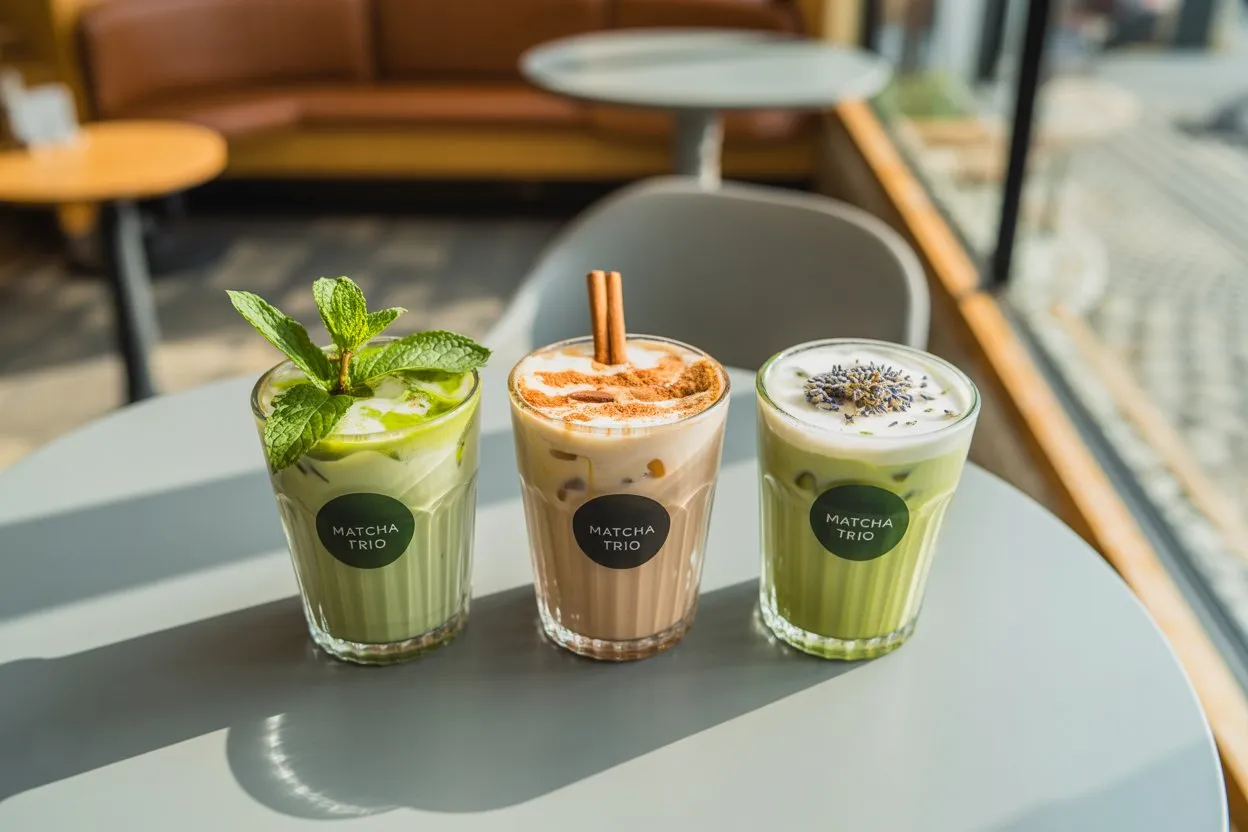Introduction
In recent years, the matcha iced latte has surged in popularity, becoming a staple in cafes and homes alike. This vibrant green beverage not only offers a unique taste but also boasts numerous health benefits. Whether you’re a seasoned matcha enthusiast or a curious newcomer, this guide will walk you through crafting the perfect matcha iced latte at home.
Table of Contents
Understanding Matcha
Origins and History
Matcha, a finely ground powder made from specially grown green tea leaves, has its roots in ancient Japan. Traditionally used in tea ceremonies, matcha has transcended cultural boundaries, finding its place in modern culinary creations worldwide..Iced Matcha Latte Recipe
Health Benefits
Rich in antioxidants, particularly catechins, matcha supports overall health by combating free radicals. It also contains L-theanine, an amino acid that promotes relaxation without drowsiness, and provides a steady energy boost without the jitters associated with coffee.
Types of Matcha Powder
There are primarily two grades of matcha: ceremonial and culinary. Ceremonial grade is of higher quality, ideal for drinking, while culinary grade is suitable for cooking and baking. For the best latte experience, opt for ceremonial grade matcha.Life Made Sweeter

Essential Ingredients
Choosing the Right Matcha
Selecting high-quality matcha is crucial. Look for a vibrant green color, indicating freshness and proper processing. Brands like Ippodo Tea and Jade Leaf offer reputable ceremonial grade matcha.
Milk Options
The choice of milk can influence the flavor and texture of your latte. Options include:
- Dairy Milk: Whole milk provides a creamy texture that complements matcha’s earthiness.
- Almond Milk: Offers a nutty flavor and is a popular dairy-free alternative.
- Oat Milk: Known for its creaminess and subtle sweetness, making it a favorite among baristas.
- Coconut Milk: Adds a tropical twist with its distinct flavor.
Sweeteners and Flavor Enhancers
While matcha has a naturally sweet undertone, adding sweeteners can enhance its flavor. Consider:
- Honey: Adds natural sweetness and pairs well with matcha.
- Maple Syrup: Provides a rich, caramel-like flavor.
- Vanilla Extract: Enhances the overall taste profile.
Tools and Equipment
Traditional vs. Modern Tools
Traditionally, matcha is prepared using a bamboo whisk (chasen) and a tea bowl (chawan). However, modern tools like electric frothers and blenders have made the process more accessible.
Must-Have Kitchen Gadgets
- Fine Mesh Sieve: For sifting matcha to prevent clumps.
- Measuring Spoons: Ensures accurate proportions.
- Electric Frother: Creates a smooth and frothy texture.
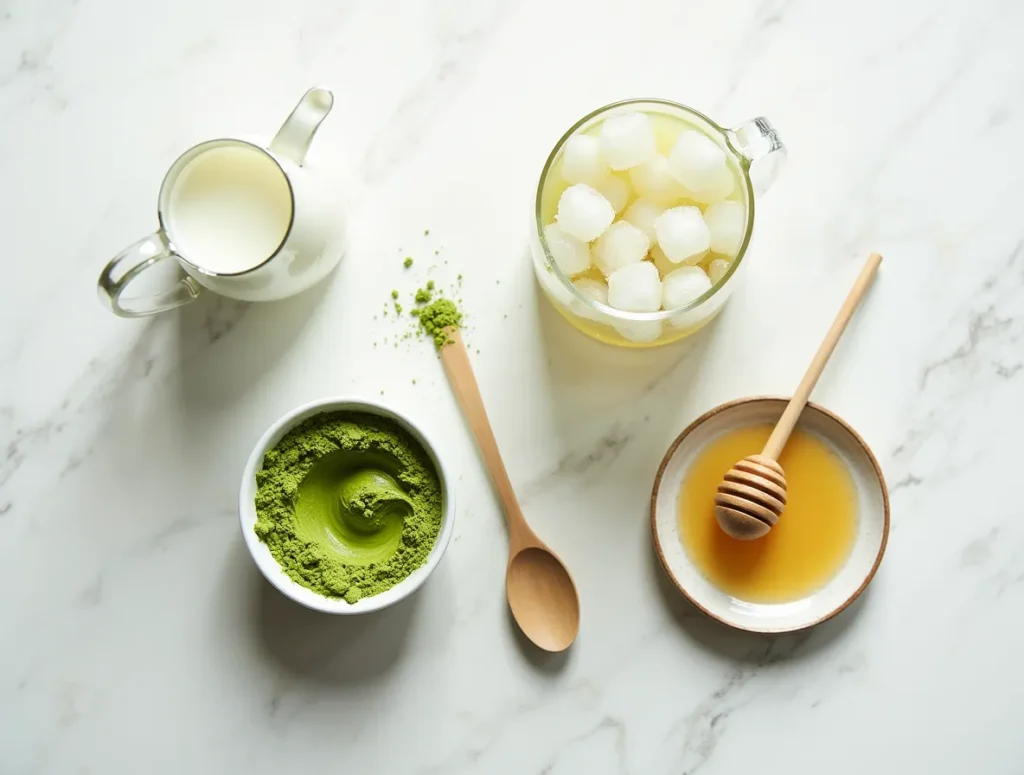
Step-by-Step Recipe
Preparing the Matcha
- Sift 2 teaspoons of ceremonial grade matcha into a bowl to remove clumps.
- Add ¼ cup of hot water (not boiling, around 175°F) to the matcha.
- Whisk vigorously in a zigzag motion until a frothy layer forms.
Mixing and Frothing
- Add sweetener of choice (e.g., 1 teaspoon of honey) to the matcha mixture.
- Froth the mixture using an electric frother or whisk until well combined.
Assembling the Latte
- Fill a glass with ice cubes.
- Pour ½ cup of milk (your choice) over the ice.
- Gently pour the matcha mixture over the milk.
- Stir gently to combine, or leave layered for a visual appeal.
Customization and Variations
Dairy-Free Alternatives
For a vegan-friendly version, opt for plant-based milks like almond, oat, or coconut milk. Each offers a unique flavor profile that complements matcha.thecrispychef
Flavor Additions
- Mint Leaves: Adds a refreshing twist.
- Cinnamon: Introduces a warm, spicy note.
- Lavender Syrup: Provides a floral aroma and taste.
Seasonal Twists
- Pumpkin Spice: Perfect for autumn vibes.
- Berry Puree: Adds a fruity dimension, ideal for summer.
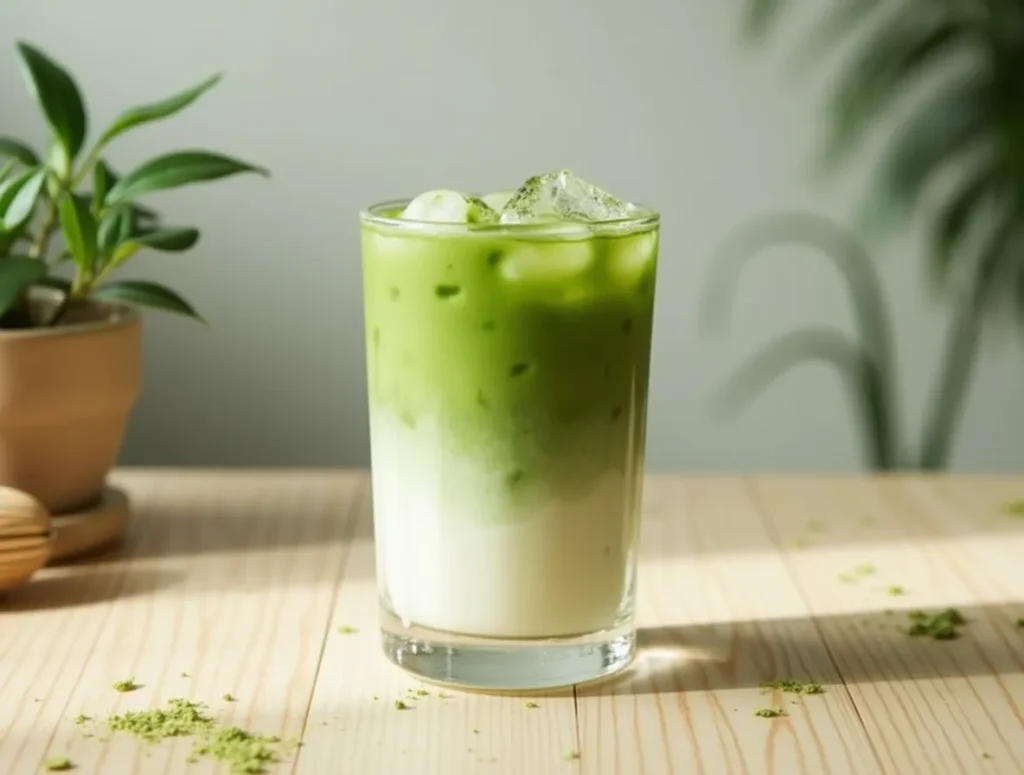
Common Mistakes to Avoid
Overheating Water
Using boiling water can scorch the matcha, resulting in a bitter taste. Always use water between 160°F and 175°F.Delish Tastes
Incorrect Ratios
Too much matcha can make the drink overly strong, while too little can render it weak. Stick to recommended measurements for a balanced flavor.Naoki Matcha
Poor Quality Matcha
Low-grade matcha lacks the vibrant color and smooth taste of higher-quality options. Investing in good matcha ensures a better latte experience..Top 10 Kratom Drink Recipes
Serving Suggestions
Ideal Pairings
Matcha iced lattes pair well with light pastries, fruit tarts, or savory snacks like rice crackers.
Presentation Tips
Serve in clear glasses to showcase the beautiful green hue. Garnish with a sprinkle of matcha powder or a mint leaf for added flair.Bon Appétit
Storage and Make-Ahead Tips
Storing Matcha Powder
Keep matcha in an airtight container, stored in a cool, dark place to maintain its freshness.
Preparing in Advance
You can prepare the matcha mixture ahead of time and store it in the refrigerator for up to 24 hours. Assemble the latte just before serving.
Nutritional Information
A standard matcha iced latte contains approximately:
- Calories: 70-100 (depending on milk and sweetener)
- Caffeine: 25-35 mg (less than a cup of coffee)
- Antioxidants: High levels, particularly catechins
Environmental Impact
Sustainable Sourcing
Opt for matcha brands that prioritize sustainable farming practices, ensuring minimal environmental impact.Life Made Sweeter
Eco-Friendly Packaging
Choose products with recyclable or biodegradable packaging to reduce waste.
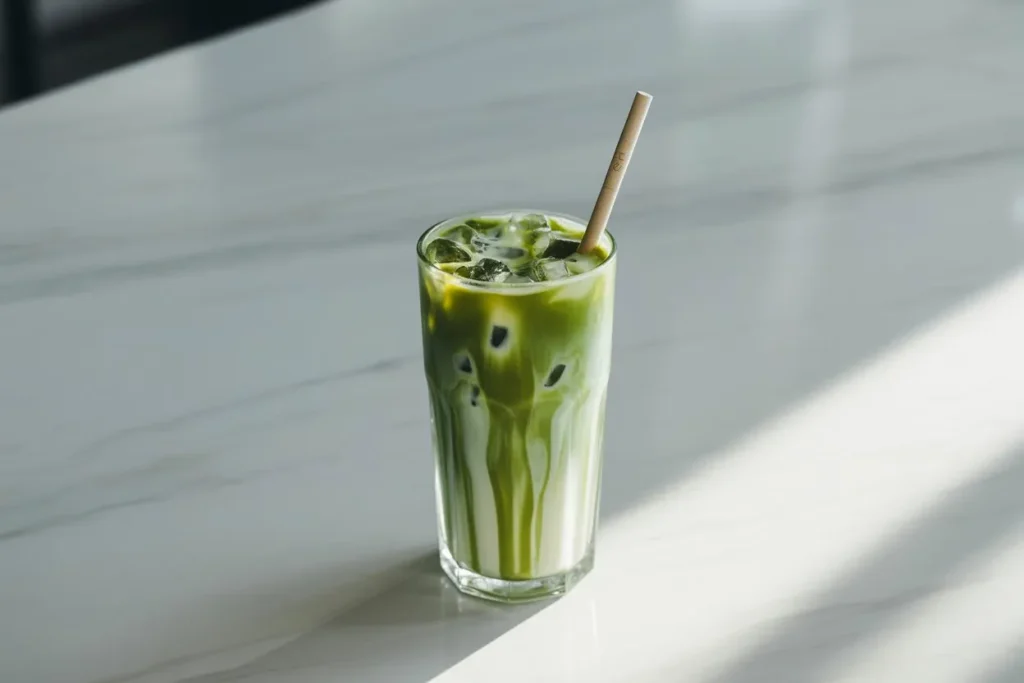
Cultural Significance
Matcha in Japanese Tea Ceremonies
Matcha holds deep cultural significance in Japan, where it has been an integral part of traditional tea ceremonies (chanoyu) for centuries. These ceremonies are not just about drinking tea — they represent mindfulness, discipline, and respect. The preparation and presentation of matcha in these settings emphasize harmony (wa), respect (kei), purity (sei), and tranquility (jaku). Participants in a tea ceremony appreciate each step of the process, from whisking the matcha to bowing before sipping, reflecting a spiritual connection to the moment and to one another.
Global Popularity
Over the last decade, matcha has broken through cultural barriers and found a dedicated global audience. Its vivid color, unique flavor, and wellness benefits have attracted influencers, health enthusiasts, and culinary innovators alike. From matcha lattes to matcha cheesecakes, it’s become a staple in Western cafes and social media food trends. The matcha iced latte, in particular, has gained traction for its eye-catching appearance and its refreshing, energizing qualities — ideal for warm weather or a midday pick-me-up.
FAQ
What is the best type of matcha for lattes?
The best type of matcha for lattes is ceremonial grade matcha. It has a vibrant green color, smooth flavor, and fewer bitter notes compared to culinary grade matcha. While slightly more expensive, it’s worth the investment for drinks where matcha is the star.
Can I use a blender instead of a matcha whisk?
Yes, a blender or even a milk frother can be used to mix matcha powder and water. These tools help break up clumps and create a smooth, frothy texture. A bamboo whisk (chasen) is more traditional but not necessary for making an iced matcha latte.
Is matcha iced latte healthier than coffee?
Matcha and coffee have different health profiles. Matcha contains antioxidants, chlorophyll, and L-theanine, offering a calming alertness. It has less caffeine than coffee, so it may be gentler on the nervous system. It’s considered a healthier option by many, especially when paired with plant-based milk and natural sweeteners.
How long does prepared matcha last in the fridge?
Prepared matcha can be stored in the refrigerator for up to 24 hours. After that, it may begin to oxidize, lose its flavor, and turn a dull brownish color. For best taste and freshness, consume it the same day.
Can I sweeten my matcha iced latte with sugar alternatives?
Absolutely. Natural sugar alternatives like stevia, monk fruit, or erythritol can be used to sweeten your matcha latte. These are great options for those following low-carb or keto lifestyles.
Does matcha have more caffeine than green tea?
Yes. Because you’re consuming the whole leaf (in powder form) rather than steeping and discarding it, matcha has more caffeine than regular green tea — typically about 25–35 mg per serving.
Conclusion
Making a matcha iced latte at home is not only simple and cost-effective but also a delightful ritual you can enjoy daily. With its rich cultural heritage, vibrant flavor, and numerous health benefits, matcha is more than just a drink — it’s a lifestyle. Whether you’re swapping out your morning coffee or simply trying something new, the matcha iced latte is a refreshing choice that delivers both flavor and function. Follow the tips, avoid common mistakes, and experiment with your own custom twists to craft your perfect cup.
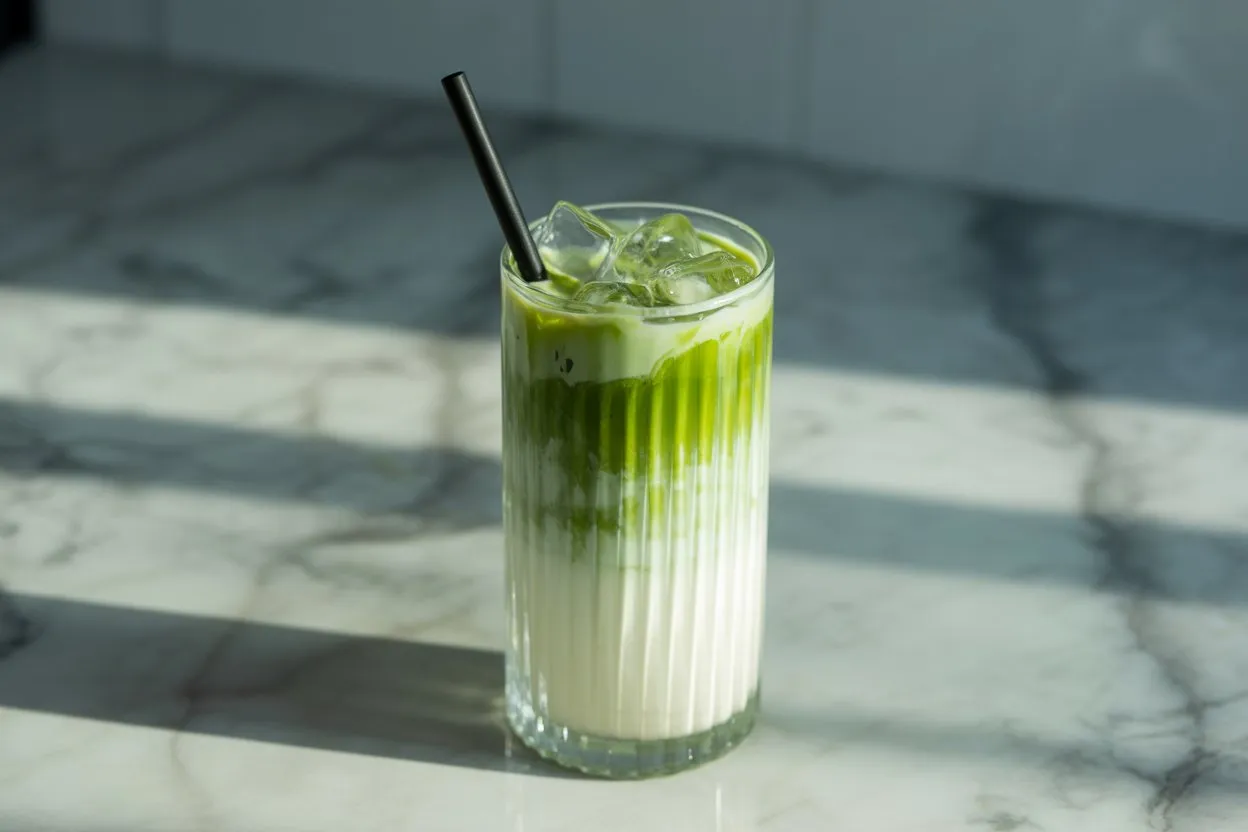
Name: Matcha Iced Latte Recipe
Ingredients
Equipment
Method
- Instructions:
- Sift the matcha powder into a small bowl using a fine mesh sieve to remove clumps.
- Add hot water and whisk using a bamboo whisk (chasen) in a zigzag motion until the matcha is fully dissolved and a light froth forms.
- Add sweetener of your choice to the matcha and stir until dissolved.
- Fill a glass with ice cubes.
- Pour milk over the ice, leaving space for the matcha layer.
- Gently pour the matcha mixture over the milk.
- Stir if desired, or leave layered for a visual appeal.
- Serve immediately and enjoy!

